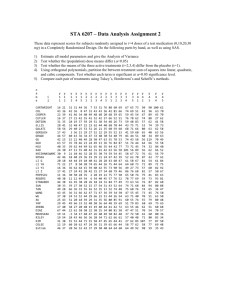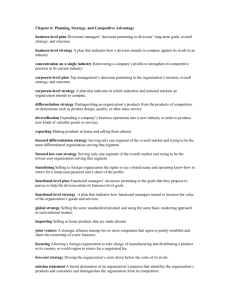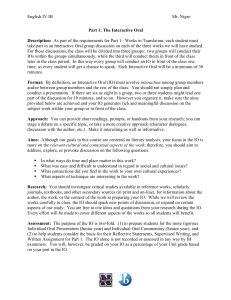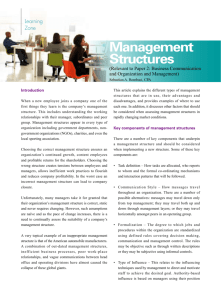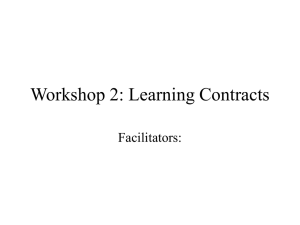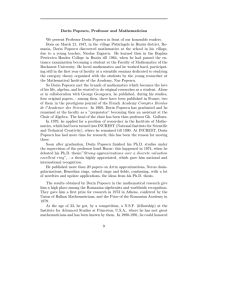IBA3_B7_Enterprise Diagnostics and
advertisement
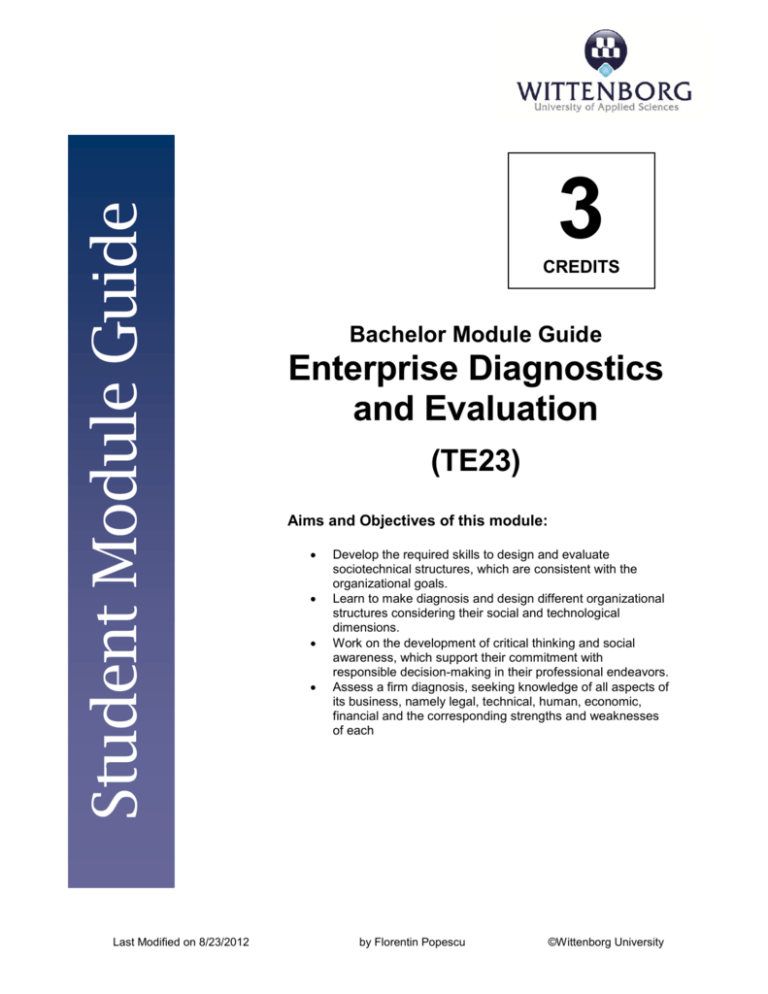
Student Module Guide Last Modified on 8/23/2012 3 CREDITS Bachelor Module Guide Enterprise Diagnostics and Evaluation (TE23) Aims and Objectives of this module: Develop the required skills to design and evaluate sociotechnical structures, which are consistent with the organizational goals. Learn to make diagnosis and design different organizational structures considering their social and technological dimensions. Work on the development of critical thinking and social awareness, which support their commitment with responsible decision-making in their professional endeavors. Assess a firm diagnosis, seeking knowledge of all aspects of its business, namely legal, technical, human, economic, financial and the corresponding strengths and weaknesses of each by Florentin Popescu ©Wittenborg University Module Description Module Name Module Code Period Teacher Email address Prerequisite Introduction Enterprise Diagnostics and Evaluation TE23 Year 3 Phase 2 Block 7 Related phase 1 modules (TE) or equivalent This thorough module showcases some of today's most current examples and research alongside time-tested principles. The students will see how many of today’s well-known organizations have learned to cope and even thrive amidst a rapidly changing, highly competitive, international environment. Featured organizations include IBM, GE, Wal-Mart, AT&T, Amazon.com, UPS, and Southwest Airlines. Organization studies, proven cases and illustrations provide the insights necessary to better understand modern organizations, while new and proven learning features give student important opportunities to apply concepts and refine their personal business skills and insights. Goals Content Instruction / Study Load Develop the required skills to design and evaluate sociotechnical structures, which are consistent with the organizational goals. Learn to make diagnosis and design different organizational structures considering their social and technological dimensions. Work on the development of critical thinking and social awareness, which support their commitment with responsible decision-making in their professional endeavors. Assess a firm diagnosis, seeking knowledge of all aspects of its business, namely legal, technical, human, economic, financial and the corresponding strengths and weaknesses of each Chapter 1: Organizations and Organizational Effectiveness Chapter 3: Organizing in a Changing Global Environment Chapter 4: Basic Challenges of Organizational Design Chapter 5: Designing Organizational Structure: Authority and Control Chapter 6: Designing Organizational Structure: Specialization and Coordination Chapter 8: Organizational Design and Strategy in a Changing Global Environment Chapter 10: Types and Forms of Organizational Change Chapter 11: Organizational Transformations: Birth, Growth, Decline, and Death 24 Lesson hours 8 Preparation Lesson hours 10 Assignments / Homework hours 20 Exam and exam preparation hours 50 Literature hours (Depending on the length and difficulty of the book) The course uses 250 pages from the book(s) and journal articles where: 250 pages average reading and understanding material – 50 hours Criteria: Difficult reading and understanding material – 3 pages per hour Average reading and understanding material – 5 pages per hour Easy reading and understanding material – 7 pages per hour IBA Final Total 112 Hours Mapped with numbers 1, 3, 8, 9, 11, 13 and 18 Last Modified on 8/23/2012 by Florentin Popescu ©Wittenborg University Qualification Mapping Teaching Language Teaching Methods Module / Lecture and seminar status Testing and assessment European Credits Required literature Recommended literature Notes: See the EEG for further reference. English - Classroom lecturing - Case study discussions - Feedback and presentation sessions - Video and film - Discussion sessions - Research Papers Compulsory Assignment / Report / Essay (2) See the EEG for further reference. 4 Organizational Theory, Design, and Change: Gareth R Jones Pearson Higher Education 2012, ISBN-10: 0273765604, ISBN-13: 9780273765608 Organization Theory and Design, Richard L. Daft, Cengage Learning 2009, ISBN10: 0324598890, ISBN13: 9780324598896 Last Modified on 8/23/2012 by Florentin Popescu ©Wittenborg University Module Plan Module Name Content Aims Required Preparation Tasks (selfstudy / homework) Content Enterprise Diagnostics and Evaluation Lesson 1 CHAPTER 1 Organizations and Organizational Effectiveness What Is an Organization? How Does an Organization Create Value? Why Do Originations Exist? Organizational Theory, Design, and Change Organizational Structure Organizational Culture Organizational Design and Change The Importance of Organizational Design and Change The Consequences of Poor Organizational Design How Do Managers Measure Organizational Effectiveness? The External Resource Approach: Control The Internal Systems Approach: Innovation The Technical Approach: Efficiency Measuring Effectiveness: Organizational Goals Explain why organizations exist and the purposes they serve. Describe the relationship between organizational theory and organizational design and change, and differentiate between organizational structure and culture. Understand how managers can utilize the principles of organizational theory to design and change their organizations to increase organizational effectiveness. Identify the three principal ways in which managers assess and measure organizational effectiveness. Appreciate the way in which several contingency factors influence the design of organizations. Chapter 1 In class given assignment. Lesson 2 CHAPTER 3 Organizing in a Changing Global Environment What Is the Organizational Environment? The Specific Environment The General Environment Sources of Uncertainty in the Organizational Environment Resource Dependence Theory Interorganizational Strategies for Managing Resource Dependencies Strategies for Managing Symbiotic Resource Interdependencies 93 Developing a Good Reputation Cooptation Strategic Alliances Merger and Takeover Strategies for Managing Competitive Resource Interdependencies Collusion and Cartels Third-Party Linkage Mechanisms Strategic Alliances Merger-and Takeover Transaction Cost Theory Sources of Transaction Costs Last Modified on 8/23/2012 by Florentin Popescu ©Wittenborg University Aims Required Preparation Tasks (selfstudy / homework) Content Aims Required Preparation Tasks (selfstudy / homework) Transaction Costs and Linkage Mechanisms Bureaucratic Costs Using Transaction Cost Theory to Choose an Interorganizational Strategy List the forces in an organization’s specific and general environment that give rise to opportunities and threats. Identify why uncertainty exists in the environment. Describe how and why an organization seeks to adapt to and control these forces to reduce uncertainty. Understand how resource dependence theory and transaction cost explain why organizations choose different kinds of inter-organizational strategies to manage their environments to gain the resources they need to achieve their goals and create value for their stakeholders. Chapter 3 In class given assignment. Lesson 3 CHAPTER 4 Basic Challenges of Organizational Design Differentiation Organizational Roles Subunits: Functions and Divisions Differentiation at the B.A.R and Grille Vertical and Horizontal Differentiation Organizational Design Challenges Balancing Differentiation and Integration Integration and Integrating Mechanisms Differentiation versus Integration Balancing Centralization and Decentralization Centralization versus Decentralization of Authority Balancing Standardization and Mutual Adjustment Formalization: Written Rules Socialization: Understood Norms Standardization versus Mutual Adjustment Mechanistic and Organic Organizational Structures Mechanistic Structures 131 Organic Structures 132 The Contingency Approach to Organizational Design Lawrence and Lorsch on Differentiation, Integration, and the Environment Bums and Stalker on Organic versus Mechanistic Structures and the Environment Describe the four basic organizational design challenges confronting managers and consultants. Discuss the way in which these challenges must be addressed simultaneously if a high performing organizational structure is to be created. Distinguish among the design choices that underlie the creation of either a mechanistic or an organic structure. Recognize how to use contingency theory to design a structure that fits an organization’s environment. Chapter 4 In class given assignment. Last Modified on 8/23/2012 by Florentin Popescu ©Wittenborg University Content Aims Required Preparation Tasks (selfstudy / homework) Content Lesson 4 CHAPTER 5 Designing Organizational Structure: Authority and Control Authority: How and Why Vertical Differentiation Occurs The Emergence of the Hierarchy Size and Height Limitations Problems with Tall Hierarchies The Parkinson s Law Problem The Ideal Number of Hierarchical Levels: The Minimum Chain of Command Span of Control Control: Factors Affecting the Shape of the Hierarchy Horizontal Differentiation Centralization Standardization The Principles of Bureaucracy The Advantages of Bureaucracy Management by Objectives The Influence of the Informal Organization IT, Empowerment and Self-Managed Teams Explain why a hierarchy of authority emerges in an organization and the process of vertical differentiation. Discuss the issues involved in designing a hierarchy to coordinate and motivate organizational behavior most effectively. Understand the way in which the design challenges such as centralization and standardization provide methods of control that substitute for the direct, personal control that managers provide and affect the design of the organizational hierarchy. Appreciate the principles of bureaucratic structure and explain their implications for the design of effective organizational hierarchies. Explain why organizations are flattening their hierarchies and making more use of empowered teams of employees, both inside and across different functions. Chapter 5 In class given assignment. Lesson 5 CHAPTER 6 Designing Organizational Structure: Specialization and Coordination Functional Structure Advantages of a Functional Structure Control Problems in a Functional Structure Solving Control Problems in a Functional Structure From Functional Structure to Divisional Structure Moving to a Divisional Structure Divisional Structure I: Three Kinds of Product Structure Product Division Structure Multidivisional Structure Product Team Structure Divisional Structure II: Geographic Structure Divisional Structure III: Market Structure Matrix Structure Advantages of a Matrix Structure Disadvantages of a Matrix Structure The Multidivisional Matrix Structure Last Modified on 8/23/2012 by Florentin Popescu ©Wittenborg University Aims Required Preparation Tasks (selfstudy / homework) Content Aims Hybrid Structure 1 Network Structure and the Boundaryless Organization Advantages of Network Structures Disadvantages of Network Structures The Boundaryless Organization E-Commerce Explain why most organizations initially have a functional structure and why, over time, problems arise with these structures that require a change to a more complex structure. Distinguish among three kinds of divisional structures (product, geographic, and market), describe how a divisional structure works, and explain why many organizations use this structure to coordinate organizational activities and increase their effectiveness. Discuss how the matrix and product team structures differ, and why and when they are chosen to coordinate organizational activities. Identify the unique properties of network structures and the conditions under which they are most likely to be selected as the design of choice Chapter 6 In class given assignment. Lesson 6 CHAPTER 8 Organizational Design and Strategy in a Changing Global Environment Strategy and the Environment Sources of Core Competences Global Expansion and Core Competences Four Levels of Strategy Functional-Level Strategy Strategies to Lower Costs or Differentiate Products Functional-Level Strategy and Structure Functional-Level Strategy and Culture Business-Level Strategy Strategies to Lower Costs or Differentiate Products Focus Strategy Business-Level Strategy and Structure Business-Level Strategy and Culture Corporate-Level Strategy Vertical Integration Related Diversification Unrelated Diversification Corporate-Level Strategy and Structure Corporate-Level Strategy and Culture Implementing Strategy Across Countries Implementing a Multidomestic Strategy Implementing International Strategy Implementing Global Strategy Implementing Transnational Strategy Identify the ways managers can use functional-level strategy to develop core competences that allow an organization to create value and give it a competitive advantage. Explain how the way managers combine their organization’s distinctive competences can create a successful business-level strategy that allows them to compete for scarce resources. Last Modified on 8/23/2012 by Florentin Popescu ©Wittenborg University Required Preparation Tasks (selfstudy / homework) Content Aims Required Preparation Tasks (selfstudy / homework) Differentiate among the corporate-level strategies companies can use to enter new domains where they can continue to grow and create value. Appreciate the importance of linking strategy to structure and culture at each level—functional, business, and corporate—to increase the ability to create value. Understand how global expansion strategies allow an organization to seek new opportunities to take advantage of its core competences to create value for stakeholders. Chapter 8 In class given assignment. Lesson 7 CHAPTER 10 Types and Forms of Organizational Change What Is Organizational Change? Targets of Change Forces for and Resistances to Organizational Change Forces for Change Resistances to Change Organization-Level Resistance to Change Group-Level Resistance to Change Individual-Level Resistance to Change Lewin s Force-Field Theory of Change Evolutionary and Revolutionary Change in Organizations Developments in Evolutionary Change: Sociotechnical Systems Theory Total Quality Management Flexible Workers and Flexible Work Teams Developments in Revolutionary Change: &engineering E-Engineering Restructuring Innovation Managing Change: Action Research Diagnosing the Organization Determining the Desired Future State Implementing Action Evaluating the Action Institutionalizing Action Research Organizational Development OD Techniques to Deal with Resistance to Change OD Techniques to Promote Change Understand the relationship among organizational change, redesign, and organizational effectiveness. Distinguish among the major forms or types of evolutionary and revolutionary change organizations must manage. Recognize the problems inherent in managing change and the obstacles that must be overcome. Describe the change process and understand the techniques that can be used to help an organization achieve its desired future state. Chapter 10 In class given assignment. Last Modified on 8/23/2012 by Florentin Popescu ©Wittenborg University Content Aims Required Preparation Tasks (selfstudy / homework) Lesson 8 CHAPTER 11 Organizational Transformations: Birth, Growth, Decline, and Death The Organizational Life Cycle Organizational Birth Developing a Plan for a New Business A Population Ecology Model of Organizational Birth Number of Births Survival Strategies The Process of Natural Selection The Institutional Theory of Organizational Growth Organizational Isomorphism Disadvantages of Isomorphism Greiner's Model of Organizational Growth Stage 1: Growth Through Creativity Stage 2: Growth Through Direction Stage 3: Growth Through Delegation Stage 4: Growth Through Coordination Stage 5: Growth Through Collaboration Organizational Decline and Death Effectiveness and Profitability Organizational Inertia Changes in the Environment Weitzel and Jonssons Model of Organizational Decline Appreciate the problems involved in surviving the perils of organizational birth and what actions founders can take to help their new organizations survive. Describe the typical problems that arise as an organization grows and matures, and how an organization must change if it is to survive and prosper. Discuss why organizational decline occurs, identify the stages of decline, and describe how managers can work to prevent the failure and even the death or dissolution of an organization Chapter 11 In class given assignment. Last Modified on 8/23/2012 by Florentin Popescu ©Wittenborg University Module Evaluation Plan Module Name Evaluation 2 Enterprise Diagnostics and Evaluation Block Type of Evaluation 7 Assignment / Report / Essay Total mark required for pass 5.5 % Weight of Final Module Mark 100% Total must equal 100% Short explanation There is a short description of this in the Education Guide under Examinations and Evaluation leading to EC Credits. Content of the exam covers the topics that have been given in the module plan. Teacher explanation: Final mark required for pass:5.5 Notes: Required Attendance of 75 % of the lecture. If students miss more than 1 lesson in a block of 4 weeks, they can be barred from taking the exam at the Exam week, and will be required to wait until the re-sit at the following block Exam week. After this, the next opportunity will be the following year. Last Modified on 8/23/2012 by Florentin Popescu ©Wittenborg University

